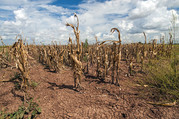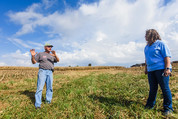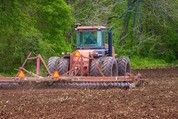|
Deadline extended
|
Emergency Relief Program (ERP) Phase One Deadline
|
|
Sept 30
|
NAP Coverage Deadline for all perennial grasses, alfalfa, clover, and mixed forage; all small grains such as barley, oats, wheat, and rye; and value loss crops (aquaculture, Christmas trees, finfish, floriculture, ginseng root, ginseng seed, mollusk, mushrooms, and turf grass sod)
|
|
Sept 30
|
Acreage Reporting Deadline for value loss/controlled environment crops for subsequent year (except nursery). Includes Mollusk, Christmas trees, floriculture and turf grass sod.
|
|
Oct 10
|
All Service Centers Closed for Columbus Day
|
|
Nov. 11
|
All Service Centers Closed for Veterans Day
|
|
Nov. 15
|
Acreage Reporting Deadline for Fall Seeded Small Grains
|
|
Nov. 21
|
NAP Coverage Deadline for perennial fruits and nuts, strawberries, asparagus, ginger, horseradish, and rhubarb
|
|
Ongoing
|
Conservation Reserve Program (CRP) - Continuous Enrollment
|

The fall season is upon us, as the temperature drops and sweaters come out, our FSA offices are still focused on the Emergency Relief Program (ERP). Congress passed this emergency funding to help agricultural producers offset the impacts of natural disasters in 2020 and 2021. ERP has already paid New York farmers more than 31 million dollars. Eligible producers should have received a pre-filled application in the mail. To be an eligible producer you must have carried commercial crop insurance or coverage through the Noninsured Crop Disaster Assistance Program (NAP) coverage in 2020 and/or 2021. For more information contact your local FSA office, or visit FSA’s Emergency Relief webpage.
Speaking of NAP, the sign-up period for 2023 crops has begun. September 30th is the deadline for perennial grasses, alfalfa, clover, and mixed forage; all small grains; and value loss crops like aquaculture, Christmas trees and mushrooms. NAP is a risk management tool for crops you can't cover through federal crop insurance in your county. The drought conditions much of the state are feeling this summer is a good example of why this is an important tool. Contact your local office for more information.
Have a safe and plentiful harvest season!
Sincerely,
Jim Barber
|

The Noninsured Crop Disaster Assistance Program (NAP) provides financial assistance to you for crops that aren’t eligible for crop insurance to protect against lower yields or crops unable to be planted due to natural disasters including freeze, hail, excessive moisture, excessive wind or hurricanes, flood, excessive heat and qualifying drought (includes native grass for grazing), among others.
In order to participate, you must obtain NAP coverage for the crop year by the applicable deadline using form CCC-471 “Application for Coverage” and pay the service fee. Application closing dates vary by crop. Producers are also required to submit an acceptable crop acreage report. Additionally, NAP participants must provide:
- The quantity of all harvested production of the crop in which the producer held an interest during the crop year
- The disposition of the harvested crop, such as whether it is marketable, unmarketable, salvaged or used differently than intended
- Acceptable crop production records (when requested by FSA)
Producers who fail to report acreage and production information for NAP-covered crops could see reduced or zero NAP assistance. These reports are used to calculate the approved yield.
If your NAP-covered crops are affected by a natural disaster, notify your FSA office by completing Part B of form CCC-576 “Notice of Loss and Application for Payment.” This must be completed within 15 calendar days of the occurrence of the disaster or when losses become apparent or 15 days of the final harvest date. For hand-harvested crops and certain perishable crops, you must notify FSA within 72 hours of when a loss becomes apparent.
To receive benefits, you must also complete Parts D, E, F and G of the CCC-576 “Notice of Loss and Application for Payment” within 60 days of the last day of coverage for the crop year for any NAP covered crops. The CCC-576 requires acceptable appraisal information. Producers must provide evidence of production and note whether the crop was marketable, unmarketable, salvaged or used differently than intended.
Eligible crops must be commercially produced agricultural commodities for which crop insurance is not available, including perennial grass forage and grazing crops, fruits, vegetables, mushrooms, floriculture, ornamental nursery, aquaculture, turf grass, ginseng, honey, syrup, bioenergy, and industrial crops.
For more information on NAP, contact your local USDA Service Center or visit fsa.usda.gov/nap.
|

The USDA Farm Service Agency’s (FSA) Direct Farm Ownership loans are a resource to help farmers and ranchers become owner-operators of family farms, improve and expand current operations, increase agricultural productivity, and assist with land tenure to save farmland for future generations.
There are three types of Direct Farm Ownership Loans: regular, down payment and joint financing. FSA also offers a Direct Farm Ownership Microloan option for smaller financial needs up to $50,000.
Direct Farm Ownership Loans can be used to construct, purchase or improve farm dwellings, service buildings or other facilities, and to make improvements essential to an operation.
Applicants must provide FSA with an estimate of the total cost of all planned development that completely describe the work, prior to loan approval and must show proof of sufficient funds to pay for the total cost of all planned development at or before loan closing. In some instances, applicants may be asked to provide certified plans, specifications or contract documents. The applicant cannot incur any debts for materials or labor or make any expenditures for development purposes prior to loan closing with the expectation of being reimbursed from FSA funds.
Construction and development work may be performed either by the contract method or the borrower method. Under the contract method, construction and development contractors perform work according to a written contract with the applicant or borrower. If applying for a direct loan to finance a construction project, the applicant must obtain a surety bond that guarantees both payment and performance in the amount of the construction contract from a construction contractor.
A surety bond is required when a contract exceeds $100,000. An authorized agency official determines that a surety bond appears advisable to protect the borrower against default of the contractor or a contract provides for partial payments in excess of the amount of 60 percent of the value of the work in place.
Under the borrower method, the applicant or borrower will perform the construction and development work. The borrower method may only be used when the authorized agency official determines, based on information from the applicant, that the applicant possesses or arranges to obtain the necessary skill and managerial ability to complete the work satisfactorily and that such work will not interfere with the applicant’s farming operation or work schedule.
Potential applicants should visit with FSA early in the initial project planning process to ensure environmental compliance.
For more eligibility requirements and information about FSA Loan programs, contact your local USDA Service Center or visit fsa.usda.gov.
|
Farm Service Agency (FSA) is hiring full time Program Technicians (PT) in numerous New York counties. The deadline to apply is approaching. Click here to see where we are hiring in New York, and when the deadline application is. Applications must be submitted through www.usajobs.gov.
Duties include general office activities supporting FSA programs administered at the field level. Successful applicants must be reliable, have a professional attitude and enjoy working with the public.
If you are interested or know of someone who might be interested, please share this information with them.
USDA is an equal opportunity provider, employer and lender.

The Farm Service Agency’s (FSA) Farm Storage Facility Loan (FSFL) program provides low-interest financing to help you build or upgrade storage facilities and to purchase portable (new or used) structures, equipment and storage and handling trucks.
Eligible commodities include corn, grain sorghum, rice, soybeans, oats, peanuts, wheat, barley, minor oilseeds harvested as whole grain, pulse crops (lentils, chickpeas and dry peas), hay, honey, renewable biomass, fruits, nuts and vegetables for cold storage facilities, floriculture, hops, maple sap and syrup, rye, milk, cheese, butter, yogurt, meat and poultry (unprocessed), eggs, and aquaculture (excluding systems that maintain live animals through uptake and discharge of water). Qualified facilities include grain bins, hay barns and cold storage facilities for eligible commodities.
Loans up to $50,000 can be secured by a promissory note/security agreement, loans between $50,000 and $100,000 may require additional security, and loans exceeding $100,000 require additional security.
You do not need to demonstrate the lack of commercial credit availability to apply. The loans are designed to assist a diverse range of farming operations, including small and mid-sized businesses, new farmers, operations supplying local food and farmers markets, non-traditional farm products, and underserved producers.
For more information, contact your local USDA Service Center or visit fsa.usda.gov/pricesupport.
|

USDA welcomed the passage of the Inflation Reduction Act, which will deliver $19.5 billion in new conservation funding to support climate-smart agriculture. This historic funding will bolster the new steps that USDA’s Natural Resources Conservation Service (NRCS) announced to improve opportunities for nutrient management. NRCS will target funding, increasing program flexibilities, launch a new outreach campaign to promote nutrient management’s economic benefits, in addition to expanding partnerships to develop nutrient management plans. This is part of USDA’s broader effort to address future fertilizer availability and cost challenges for U.S. producers.
Through USDA’s conservation programs, America’s farmers and ranchers will have streamlined opportunities to improve their nutrient management planning, which provides conservation benefits while mitigating the impacts of supply chain disruptions and increased input costs.
Specifically, NRCS efforts include:
-
Streamlined Nutrient Management Initiative – A streamlined initative will incentivize nutrient management activities through key conservation programs, including the Environmental Quality Incentives Program (EQIP), EQIP Conservation Incentive Contracts, and the Conservation Stewardship Program. The initiative will use a ranking threshold for pre-approval and include a streamlined and expedited application process, targeted outreach to small-scale and historically underserved producers, and coordination with FSA to streamline the program eligibility process for producers new to USDA. In addition to otherwise available funding at the state level, NRCS is targeting additional FY23 funds for nutrient management. NRCS is also announcing a streamlined funding opportunity for up to $40 million in nutrient management grant opportunities through the Regional Conservation Partnership Program (RCPP).
-
Nutrient Management Economic Benefits Outreach Campaign – A new outreach campaign will highlight the economic benefits of nutrient management planning for farmers. The potential net savings to farmers who adopt a nutrient management plan is estimated to be an average of $30 per acre for cropland. It is estimated that there are 89 million acres of cropland (28% of total U.S. cropland) currently exceeding the nitrogen loss threshold; and if all those acres implemented a nutrient management plan, the average net savings would be $2.6 billion. NRCS staff develop nutrient management plans to help producers use nutrient resources effectively and efficiently to adequately supply soils and plants with necessary nutrients while minimizing transport of nutrients to ground and surface waters. Producer information is available at farmers.gov/global-food-security.
-
Expanded Nutrient Management Support through Technical Service Providers Streamlining and Pilots – New agreements with key partners who have existing capacity to support nutrient management planning and technical assistance will expand benefits and serve as a model to continue streamlining the certification process for Technical Service Providers (TSPs). NRCS is also developing new opportunities to support partner training frameworks, nutrient management outreach and education, and new incentive payments through TSP partners for nutrient management planning and implementation.
Alongside the Bipartisan Infrastructure Act and American Rescue Plan, the Inflation Reduction Act provides once-in-a-generation investment in rural communities and their infrastructure needs, while also responding to the climate crisis. The bill invests $40 billion into existing USDA programs promoting climate smart agriculture, rural energy efficiency and reliability, forest conservation, and more.
Approximately $20 billion of this investment will support conservation programs that are oversubscribed, meaning that more producers will have access to conservation assistance that will support healthier land and water, improve the resilience of their operations, support their bottom line, and combat climate change. This includes:
- $8.45 billion for EQIP
- $4.95 billion for the Regional Conservation Partnership Program (RCPP)
- $3.25 billion for the Conservation Stewardship Program (CSP)
- $1.4 billion for the Agricultural Conservation Easement Program (ACEP)
For more information and resources for nutrient management planning, visit farmers.gov/global-food-insecurity. Contact NRCS at your local USDA Service Center to get assistance with a nutrient management plan for your land.
|

FSA offers direct farm ownership and direct farm operating loans to producers who want to establish, maintain, or strengthen their farm or ranch. Direct loans are processed, approved and serviced by FSA loan officers.
Direct farm operating loans can be used to purchase livestock and feed, farm equipment, fuel, farm chemicals, insurance, and other costs including family living expenses. Operating loans can also be used to finance minor improvements or repairs to buildings and to refinance some farm-related debts, excluding real estate.
Direct farm ownership loans can be used to purchase farmland, enlarge an existing farm, construct and repair buildings, and to make farm improvements.
The maximum loan amount for direct farm ownership loans is $600,000 and the maximum loan amount for direct operating loans is $400,000 and a down payment is not required. Repayment terms vary depending on the type of loan, collateral and the producer's ability to repay the loan. Operating loans are normally repaid within seven years and farm ownership loans are not to exceed 40 years.
Please contact your local FSA office for more information or to apply for a direct farm ownership or operating loan.
|
A new multi-agency guide for USDA assistance for underserved farmers and ranchers is now available. If you are a farmer or rancher and are a minority, woman, veteran, beginning, or limited resource producer, you can use this booklet to learn about assistance and targeted opportunities available to you. This includes programs offered through the Farm Service Agency, Natural Resources Conservation Service, and Risk Management Agency. The guide is also available in Spanish, Hmong, Korean, Vietnamese, Thai and Chinese on farmers.gov/translations.

The term “sodbusting” is used to identify the conversion of land from native vegetation to commodity crop production after December 23, 1985. As part of the conservation provisions of the Food Security Act of 1985, if you’re proposing to produce agricultural commodities (crops that require annual tillage including one pass planting operations and sugar cane) on land that has been determined highly erodible and that has no crop history prior to December 23, 1985, that land must be farmed in accordance with a conservation plan or system that ensures no substantial increase in soil erosion.
Eligibility for many USDA programs requires compliance with a conservation plan or system on highly erodible land (HEL) used for the production of agricultural commodities. This includes Farm Service Agency (FSA) loan, disaster assistance, safety net, price support, and conservation programs; Natural Resources Conservation Service (NRCS) conservation programs; and Risk Management Agency (RMA) Federal crop insurance.
Before you clear or prepare areas not presently under production for crops that require annual tillage, you are required to file Form AD-1026 “Highly Erodible Land Conservation and Wetland Conservation Certification,” with FSA indicating the area to be brought into production. The notification will be referred to NRCS to determine if the field is considered highly erodible land. If the field is considered HEL, you are required to implement a conservation plan or system that limits the erosion to the tolerable soil loss (T) for the predominant HEL soil on those fields.
In addition, prior to removing trees or conducting any other land manipulations that may affect wetlands, remember to update form AD-1026, to ensure you remain in compliance with the wetland conservation provisions.
Prior to purchasing or renting new cropland acres, it is recommended that you check with your local USDA Service Center to ensure your activities will be in compliance with the highly erodible land and wetland conservation provisions.
For additional information on highly erodible land conservation and wetland conservation compliance, contact your local USDA Service Center.
|
USDA is expanding its People’s Garden Initiative to include eligible gardens nationwide. School gardens, community gardens, urban farms, and small-scale agriculture projects in rural, suburban and urban areas can be recognized as a “People’s Garden” if they register on the USDA website and meet criteria including benefitting the community, working collaboratively, incorporating conservation practices and educating the public. Affiliate People’s Garden locations will be indicated on a map on the USDA website, featured in USDA communications, and provided with a People’s Garden sign. <link to release>
|